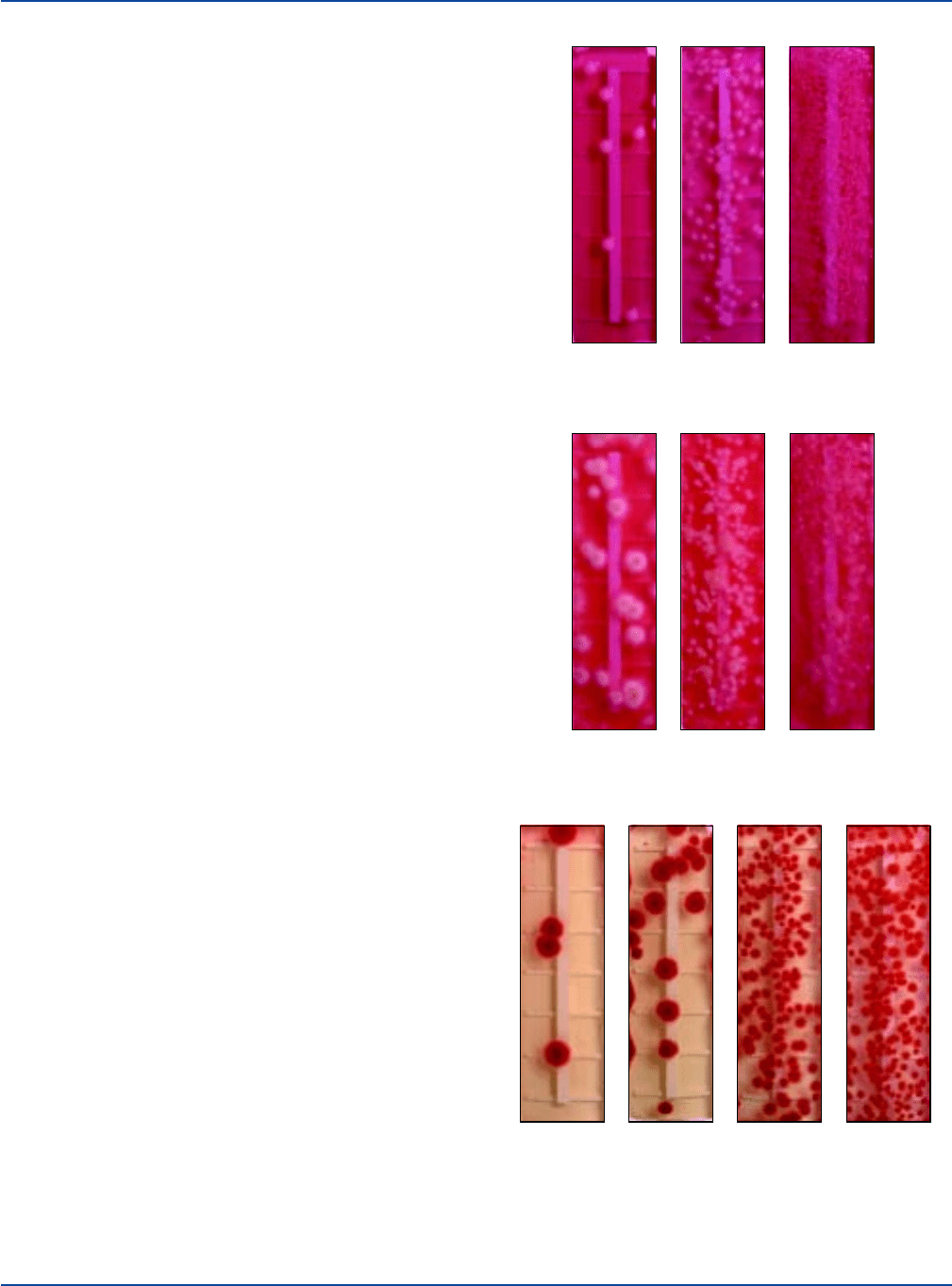BD Diagnostic Systems (publ.). Difco Manual (Manual of Microbiological Culture)
Подождите немного. Документ загружается.


588 The Difco Manual
2. Kleitmann, W. 1995. Resistance and susceptibility testing for
Mycobacterium tuberculosis. Clin. Microbiol. News 17:65-69.
3. Woodruff, C. E., D. Crombie, J. S. Woolley, E. Medlar, and
W. Steeken. 1946. Report of the committee on evaluation of
laboratory procedures. Am. Rev. Tuberc. 54:428-432.
4. Nolte, F. S., and B. Methcock. 1995. Mycobacterium, p. 400-437.
In P. R. Murray, E. J. Baron, M. A. Pfaller, F. C. Tenover, and
Bacto
®
Dubos Albumin Broth
See page 163 of Section II for complete listing of this product.
HYcheck
™
HYcheck D/E Neutralizing Agar
.
HYcheck for Disinfection
Control
.
HYcheck for Enterobacteriaceae
.
HYcheck Plate
Count Agar With TTC
.
HYcheck for Total Count
.
HYcheck for
Yeasts and Molds
.
HYcheck for Yeasts and Molds with TTC
Intended Use
HYcheck is a hygiene contact slide which is used for assessing the
microbiological contamination of surfaces or fluids.
Summary and Explanation
Monitoring the microbial flora of environmental surfaces, walls, ceilings,
and equipment is an important stage in achieving good manufacturing
practices in factories handling foods, cosmetics or pharmaceuticals.
1,2,3
To maintain good hygiene standards in hotels and restaurant kitchens,
microbiological contamination must also be monitored.
4
Methods to
monitor the environmental flora have been described using either swabbing
techniques
5
or contact plates.
6
Contact slides were created to monitor
the microbial flora of liquids (e.g. urine, milk) and equipment surfaces
in the clinical and food industries.
1
Contact slides are statistically
comparable to swab and contact plates for surface sampling.
1
The
HYcheck contact slides were developed for the testing of fluids and
surfaces for microbial cleanliness.
HYcheck is a double sided, hinged plastic paddle containing two agar
surfaces. The agar surface extends above the paddle allowing for contact
with test surfaces. The hinged paddle allows the agar surface to be
easily held against each test area during sampling. The surface area of
the paddle is clearly divided into seven units of one centimeter each to
allow direct counting of microbial density per unit area.
The HYcheck range of hygiene control slides consists of seven media
combinations designed to meet the various needs for monitoring different
types of microbial contamination.
HYcheck D/E Neutralizing Agar has both sides coated with
D/E Neutralizing Agar, a medium developed by Dey and Engley
7
to
neutralize a broad spectrum of disinfectants and preservative antimicrobial
chemicals. D/E Neutralizing Agar neutralizes higher concentrations of
residual antimicrobials, when compared with other standard neutralizing
formulas, such as Letheen media, Thioglycollate media, and Neutralizing
Buffer.
8,9
Complete neutralization of disinfectants is important because
disinfectant carryover can result in a false no growth result. D/E
Neutralizing media effectively neutralize the inhibitory effects of
disinfectant carryover,
10,11
allowing differentiation between bacteriostasis
and true bactericidal actions of disinfectant chemicals.
HYcheck Section III
User Quality Control
Identity Specifications
HYcheck D/E Neutralizing Agar
Medium: D/E Neutralizing Agar
Appearance: Lavender
Microbial Limits Test: Satisfactory
pH at 25°C: 7.6 ± 0.2
HYcheck for Disinfection Control
Media: D/E Neutralizing Agar Tryptic Soy Agar
Appearance: Lavender Light amber
Microbial
Limits Test: Satisfactory Satisfactory
pH at 25°C: 7.6 ± 0.2 7.3 ± 0.2
continued on following page
R. H. Yolken (ed.), Manual of clinical microbiology, 6th ed.
American Society for Microbiology, Washington, D.C.
5. Isenberg, H. D. (ed.). 1994. Clinical microbiology procedures hand-
book, sup. 1. American Society for Microbiology, Washington, D.C.
Packaging
ATS Medium 100 tubes 1019-79
*

The Difco Manual 589
HYcheck for Enterobacteriaceae
Media: Violet Red Bile Tryptic Soy Agar
Glucose Agar
Appearance: Reddish purple Light amber
Microbial
Limits Test: Satisfactory Satisfactory
pH at 25°C: 7.4 ± 0.2 7.3 ± 0.2
HYcheck Plate Count Agar with TTC
Medium: Plate Count Agar with 0.01% TTC
Appearance: Light amber
Microbial Limits Test: Satisfactory
pH at 25°C: 7.0 ± 0.2
HYcheck for Total Count
Media: Plate Count Agar Plate Count Agar
with 0.01% TTC
Appearance: Light amber Light amber
Microbial
Limits Test: Satisfactory Satisfactory
pH at 25°C: 7.0 ± 0.2 7.0 ± 0.2
HYcheck for Yeasts and Molds
Media: Rose Bengal Tryptic Soy Agar
Chloramphenicol Agar
Appearance: Rose pink Light amber
Microbial
Limits Test: Satisfactory Satisfactory
pH at 25°C: 7.2 ± 0.2 7.3 ± 0.2
HYcheck for Yeast and Molds with TTC
Media: Rose Bengal Tryptic Soy Agar
Chloramphenicol Agar with 0.01% TTC
Appearance: Rose pink Light amber
Microbial
Limits Test: Satisfactory Satisfactory
pH at 25°C: 7.2 ± 0.2 7.3 ± 0.2
Cultural Response
(approx inoculum 30-300 CFU)
HYcheck D/E Neutralizing Agar
Inoculate and incubate at 35 ± 2°C for 18-48 hours.
ORGANISM ATCC
®
GROWTH ON D/E AGAR
Aspergillus niger NCPF 2275 – good
Bacillus subtilis 6633 good
Candida albicans 2091 good
Escherichia coli 25922* good
Pseudomonas aeruginosa 27853* good
Staphylococcus aureus 25923* good
Staphylococcus epidermidis 12228* good
HYcheck for Disinfection Control
Inoculate and incubate at 35 ± 2°C for 18-48 hours.
GROWTH GROWTH
ORGANISM ATCC
®
ON D/E ON TSA
Aspergillus niger NCPF 2275 – good good
Bacillus subtilis 6633 good good
Candida albicans 2091 good good
Escherichia coli 25922* good good
Pseudomonas /nosa 27853* good good
Staphylococcus aureus 25923* good good
Staphylococcus epidermidis 12228* good good
HYcheck for Enterobacteriaceae
Inoculate and incubate at 35 ± 2°C for 18-24 hours.
GROWTH GROWTH
ORGANISM ATCC
®
ON VRBGA ON TSA
Enterobacter aerogenes 13048* good good
Enterococcus faecalis 19433* none to poor good
Escherichia coli 25922* good good
Proteus mirabilis NCTC 11938 – good good
Salmonella typhimurium 14028* good good
Shigella sonnei 25931* good good
Staphylococcus aureus 25923* none to poor good
HYcheck Plate Count Agar with TTC
Inoculate and incubate at 35 ± 2°C for 18-24 hours.
GROWTH
ORGANISM ATCC
®
ON PCA W/TTC
Enterococcus faecalis 19433* good
Escherichia coli 25922* good
Proteus vulgaris 13315 good
Salmonella typhimurium 14028* good
Staphylococcus aureus 25923* poor
HYcheck for Total Count
Inoculate and incubate at 35 ± 2°C for 18-24 hours.
GROWTH GROWTH
ORGANISM ATCC
®
ON PCA ON PCA W/TTC
Enterococcus faecalis 19433* good good
Escherichia coli 25922* good good
Proteus vulgaris 13315 good good
Salmonella typhimurium 14028* good good
Staphylococcus aureus 25923* good poor
HYcheck for Yeasts and Molds
Inoculate and incubate at 30 ± 2
o
C for 18-48 hours.
GROWTH GROWTH
ORGANISM ATCC
®
ON RBCA ON TSA
Aspergillus niger NCPF 2275 – good good
Candida albicans 2091 good good
Escherichia coli 25922* none to poor good
Saccharomyces cerevisiae NCYC 1211 – good good
Serratia marcescens 8100 none to poor good
Staphylococcus aureus 25923* none to poor good
Streptococcus pyogenes 19615* none to poor good
HYcheck for Yeasts and Molds with TTC
Inoculate and incubate at 30 ± 2°C for 18-48 hours.
GROWTH GROWTH
ORGANISM ATCC
®
ON RBCA ON TSA W/TTC
Aspergillus niger NCPF 2275 — good good
Candida albicans 2091 good good
Escherichia coli 25922* none to poor good
Saccharomyces cerevisiae NCYC 1211 – good poor
Serratia marcescens 8100 none to poor good
Staphylococcus aureus 25923* none to poor poor
Streptococcus pyogenes 19615* none to poor good
The cultures listed are the minimum that should be used for
performance testing.
*These cultures are available as Bactrol
™
Disks and should be used
as directed in Bactrol Disks Technical Information.
Section III HYcheck

590 The Difco Manual
HYcheck for Disinfection Control has side one coated with
D/E Neutralizing Agar (D/E) (see above), and side two coated with
Tryptic Soy Agar (TSA). In 1955, Leavitt et al.
12
demonstrated that
Tryptic Soy Agar supports excellent growth of a both aerobic and
anaerobic microorganisms. Tryptic Soy Agar is a general purpose
medium that is recommended in multiple water and wastewater
applications.
13
HYcheck for Enterobacteriaceae has side one coated with Violet Red
Bile Glucose Agar and side two coated with Tryptic Soy Agar, a general
purpose growth medium. Violet Red Bile Glucose Agar is a selective
medium used for the enumeration of Enterobacteriaceae in foods.
Coliform bacteria have long been used as an index of fecal contamination
in waters, and their presence in milk is used as an index of sanitation in
milk processing.
14
The presence of Enterobacteriaceae, coliforms,
Salmonellae, Klebsiella or Citrobacter, in raw foodstuffs is an indicator
of fecal contamination. Their presence after processing may indicate a
failure in the manufacturing process.
HYcheck Plate Count Agar with TTC has both sides coated with
Plate Count Agar with TTC (0.01% 2,3,5-Triphenyl Tetrazolium
Chloride).
HYcheck for Total Count has side one coated with Plate Count Agar
and side two coated with Plate Count Agar with 0.01% TTC. Plate
Count Agar is used for enumerating bacteria in water, wastewater, food
and dairy products.
13,15-18
TTC is a redox indicator that is colorless in
the oxidized form. TTC is reduced to insoluble triphenylformazan by
certain actively metabolizing bacteria, resulting in a red color in the
presence of bacterial growth.
There are two HYcheck products for yeasts and molds: 1) HYcheck
for Yeasts and Molds has side one coated with Rose Bengal
Chloramphenical Agar and side two coated with Tryptic Soy Agar;
2) HYcheck for Yeasts and Molds with TTC has side one coated
with Rose Bengal Chloramphenical Agar and side two coated with
Tryptic Soy Agar with 0.01% TTC. Rose Bengal Chloramphenical Agar
is recommended in the selective isolation and enumeration of yeasts
and molds from environmental materials and foodstuffs. The pH of the
medium is near neutrality for improved growth and recovery of acid
sensitive strains.
19-21
Principles of the Procedure
HYcheck D/E Neutralizing Agar
Tryptone provides carbon and nitrogen. Yeast Extract provides vitamins,
cofactors and additional nitrogen and carbon. Dextrose provides
fermentable carbohydrate. Sodium Thioglycollate neutralizes
mercurials. Sodium Thiosulfate neutralizes iodine and chlorine. Sodium
Bisulfite neutralizes formaldehyde and glutaraldehyde. Lecithin
neutralizes quaternary ammonium compounds and Polysorbate 80
neutralizes phenols, hexachlorophene, formalin and, with lecithin,
ethanol. Brom Cresol Purple is a colorimetric indicator. Bacto Agar is
a solidifying agent.
HYcheck for Disinfection Control
D/E Neutralizing Agar (D/E) - side one
Tryptone provides carbon and nitrogen. Yeast Extract provides vitamins,
cofactors and additional nitrogen and carbon. Dextrose provides
fermentable carbohydrate. Sodium Thioglycollate neutralizes
mercurials. Sodium Thiosulfate neutralizes iodine and chlorine.
Sodium Bisulfite neutralizes formaldehyde and glutaraldehyde. Lecithin
neutralizes quaternary ammonium compounds and Polysorbate 80
neutralizes phenols, hexachlorophene, formalin and, with lecithin,
ethanol. Brom Cresol Purple is a colorimetric indicator. Bacto Agar is
a solidifying agent.
Tryptic Soy Agar (TSA) - side two
Tryptone and Soytone provide nitrogen, vitamins and minerals. The
natural sugars from the soybean promote bacterial growth. Sodium
Chloride maintains the osmotic balance of the medium. Bacto Agar is
a solidifying agent.
HYcheck for Enterobacteriaceae
Violet Red Bile Glucose Agar (VRBGA) - side one
Yeast Extract provides vitamins, cofactors, nitrogen and carbon. Glucose
provides a source of fermentable carbohydrate. Bacto Agar is a
solidifying agent.
Tryptic Soy Agar - side two
Tryptone and Soytone provide nitrogen, vitamins and minerals. The
natural sugars from the soybean promote bacterial growth. Sodium
Chloride maintains the osmotic balance of the medium. Bacto Agar is
a solidifying agent.
HYcheck Plate Count Agar (PCA) with TTC
Tryptone and Yeast Extract provide carbon and nitrogen. Dextrose
provides a source of fermentable carbohydrate. TTC is a redox indicator.
Bacto Agar is a solidifying agent.
HYcheck for Total Count
Plate Count Agar - side one
Tryptone and Yeast Extract provide carbon and nitrogen. Dextrose provides
a source of fermentable carbohydrate. Bacto Agar is a solidifying agent.
Plate Count Agar with TTC - side two
Tryptone and Yeast Extract provide carbon and nitrogen. Dextrose provides
a source of fermentable carbohydrate. TTC is a redox indicator. Bacto
Agar is a solidifying agent.
HYcheck for Yeasts and Molds
Rose Bengal Chloramphenicol Agar (RBCA) - side one
Soytone provides carbon and nitrogen. Dextrose provides a source of
fermentable carbohydrate. Rose Bengal and Chloramphenicol inhibit
bacterial growth and restrict size and height of rapidly growing mold
colonies. Bacto Agar is a solidifying agent.
Tryptic Soy Agar - side two
Tryptone and Yeast Extract provide carbon and nitrogen. Dextrose provides
a source of fermentable carbohydrate. Bacto Agar is a solidifying agent.
HYcheck for Yeasts and Molds with TTC
Rose Bengal Chloramphenicol Agar - side one
Soytone provides carbon and nitrogen. Dextrose provides a source of
fermentable carbohydrate. Rose Bengal suppresses bacterial growth
and restricts size and height of rapidly growing mold colonies.
Chloramphenicol inhibits bacteria. Bacto Agar is a solidifying agent.
HYcheck Section III

The Difco Manual 591
Tryptic Soy Agar - side two
Tryptone and Yeast Extract provide carbon and nitrogen. Dextrose provides
a source of fermentable carbohydrate. TTC is a redox indicator. Bacto
Agar is a solidifying agent.
Precautions
1. Do not touch agar surface.
2. Do not use if there are signs of dehydration or contamination.
Storage
Store HYcheck slides at 2-15°C.
Expiration Date
The expiration date applies to the product in its intact container when
stored as directed. Do not use a product if it fails to meet specifications
for identity and performance.
Procedure
Materials Provided
(One type is provided per package.)
HYcheck D/E Neutralizing Agar
HYcheck for Disinfection Control
HYcheck for Enterobacteriaceae
HYcheck Plate Count Agar with TTC
HYcheck for Total Count
HYcheck for Yeasts and Molds
HYcheck for Yeasts and Molds with TTC.
Test Procedure
Surfaces
1. Loosen cap and remove HYcheck slide from the container.
2. Examine for dehydration or contamination.
3. Hold terminal spike against surface to be tested.
4. Press down on the spike to bend the paddle around the hinge line.
5. Gently lower the slide and press agar into contact with the test surface.
6. Apply firm and even pressure on the test surface for a few seconds.
7. Repeat procedure using the second agar surface on an area adjacent
to the initial test site.
8. Replace slide in the container and close tightly.
9. Incubate in an upright position at indicated temperature.
Liquids
1. Loosen cap and remove HYcheck Slide from the container.
2. Examine for dehydration or contamination.
3. Immerse slide into test fluid so that agar surface becomes totally
covered (if insufficient liquid is available, pour over surface of
the slide).
4. Allow to drain.
5. Replace slide in the container and close tightly.
6. Incubate in an upright position at indicated temperature.
Results
The following photos are reactions to Candida albicans, Aspergillus
niger and Escherichia coli.
Escherichia coli
ATCC
®
11229
on Tryptic Soy Agar with 0.01% TTC
10
3
10
4
10
5
10
6
Aspergillus niger
ATCC
®
1015
on Rose Bengal Chloramphenicol Agar
10
3
10
4
10
5
Candida albicans
ATCC
®
60193
on Rose Bengal Chloramphenicol Agar
10
3
10
4
10
5
Limitations of the Procedure
1. Do not use the HYcheck Slide if it is contaminated or the agar
medium is significantly dehydrated.
Section III HYcheck

592 The Difco Manual
References
1. Restaino, L. 1994. HYcheck Slides versus contact plates compared
to the swab technique. Dairy, Food and Environ. Sanit. 14:528-530.
2. Scott, E., S.F. Bloomfield, and C.G. Barlow. 1984. A comparison
of contact plate and calcium alginate swab techniques for quantita-
tive assessment of bacteriological contamination of environmental
surfaces. J. Appl. Bact. 56:317- 320.
3. Thomas, M. E. M., E. Piper, and I. M. Mauer. 1972. Con-
tamination of an operating theatre by Gram negative bacteria.
Examination of water supplies, cleaning methods and wound
infections. J. Hygiene 70:63-73.
4. Baird, R. M. 1981. Cleaning and disinfection of the hospital
pharmacy. S.A.B. Technical Series Number 16. Disinfectants: their
use and evaluation of effectiveness.
5. Griffiths, W. E. 1978. Contact slides for use in environmental
hygiene studies. Environ. Health 86:36-37.
6. Cain, R. M., and H. Steele. 1953. The use of calcium alginate
soluble wool for the examination of cleansed eating utensils. Can.
J. Pub. Health 44:464-467.
7. Dey, B. P., and F. B. Engley, Jr. 1970. A universal neutralizing
medium for antimicrobial chemicals. Presented at the Chemical
Specialties Manufacturing Association (CSMA) Proceedings
56th mid year.
8. Dey, B. P., and F. B. Engley, Jr. 1983. Methodology for recovery
of chemically treated Staphylococcus aureus with neutralizing
medium. Appl. Environ. Microbiol. 45:1533-1537.
9. Dey, B. P., and F. B. Engley, Jr. 1978. Environmental sampling
devices for neutralization of disinfectants. Presented at the 4th
International Symposium on Contamination Control.
10. Dey, B. P., and F. B. Engley, Jr. 1994. Neutralization of antimi-
crobial chemicals by recovery media. J. Microbiol. Methods
19:51-58.
11. Dey, B. P., and F. B. Engley, Jr. 1995. Comparison of Dey and
Engley (D/E) neutralizing medium to letheen medium and standard
methods medium for recovery of Staphylococcus aureus from
sanitized surfaces. J. Ind. Microbiol. 14:21-25.
12. Leavitt, J. M., I. J. Naidorf, and P. Shugaevsky. 1955. The unde-
tected anaerobe in endodontics; a sensitive medium for detection
of both aerobes and anaerobes. The N.Y. J. Dentist. 25:377-382.
13. Greenberg, A. E., L. S. Clesceri and A. D. Eaton (ed.). 1995.
Standard methods for the examination of water and wastewater,
19th ed. American Public Health Association, Washington, D.C.
14. International Dairy Federation. Milk and milk products-count
of coliform bacteria. International Dairy Federation Standard
FIL-IDF 73:1974.
15. Swanson, K. J., F. F. Busta, E. H. Peterson, and M. G. Johnson.
1992. Colony Count Methods, p.75-95. In C. Vanderzant, and D. F.
Splittstoesser (ed.), Compendium of methods for the microbiological
examination of foods, 3rd ed. American Public Health Association,
Washington, D.C.
16. Marshall, R. T. (ed.). 1993. Standard methods for the examination
of dairy products, 16th ed. American Public Health Association,
Washington, D.C.
17. Association of Official Agricultural Chemists. 1995. Official
methods of analysis, 16th ed. Association of Official Agricultural
Chemists, Washington, D.C.
18. Bandler, R., M. E. Stack, H. A. Koch, V. H. Tournas, and P. B.
Mislivec. 1995. Yeasts, molds and mycotoxins, p. 18.01-18.03.
In FDA Bacteriological Manual, 8th ed. AOAC International,
Arlington, VA.
19. Martin, J. P. 1950. Use of acid, rose bengal and streptomycin in
the plate method for estimating soil fungi. Soil Sci. 69:215-232.
20. Koburger, J. A. 1972. Fungi in foods. IV. Effect of plating
medium pH on counts. J. Milk Food Technol. 35:659-660.
21. Jarvis, B. 1973. Comparison of an improved rose bengal-
chlortetracycline agar with other media for the selective isolation
and enumeration of molds and yeasts in foods. J. Appl. Bact.
36:723-727.
Packaging
HYcheck D/E Neutralizing Agar 20 units 9041-36
HYcheck for Disinfection Control 20 units 9039-36
HYcheck for Enterobacteriaceae 20 units 9037-36
HYcheck Plate Count Agar with TTC 20 units 9045-36
HYcheck for Total Count 20 units 9053-36
HYcheck for Yeasts and Molds 20 units 9038-36
HYcheck for Yeasts and Molds with TTC 20 units 9046-36
Petragnani Medium Section III
Bacto
®
Petragnani Medium
Intended Use
Bacto Petragnani Medium is used for isolating and cultivating
mycobacteria.
Summary and Explanation
Mycobacterial infections, particularly tuberculosis, are a worldwide
health problem. Almost three million people worldwide die of tuber-
culosis each year.
1
During the mid 1980s. the number of tuberculosis
(TB) cases in the U.S. began increasing. Before this time, the number
of cases in the U.S. had been decreasing, reaching a low in 1984.
2
Non-tuberculous mycobacterial infections have also increased since
the mid 1980s.
3
Two types of semi-solid culture media are available for the isolation
of mycobacteria, egg-based media and agar-based media. Most
formulations for the isolation of mycobacteria include malachite
green, which is used to inhibit contaminating organisms.
Petragnani Medium is an egg-based medium
that is a modification of
Petragnani
4
medium described by Norton, Thomor and Broom.
5
The
formulation contains a large amount of malachite green which

The Difco Manual 593
Section III Petragnani Medium
User Quality Control
Identity Specifications
Prepared Appearance: Light to medium green, opaque, smooth
slants with no visible contamination.
Reaction of
Medium at 25°C: pH 7.2 ± 0.2
Cultural Response
Inoculate and incubate at 35 ± 2°C under CO
2
for up to 21 days.
INOCULUM
ORGANISM ATCC
®
CFU GROWTH
Escherichia coli 25922* 1,000-2,000 partial to
complete inhibition
Mycobacterium fortuitum 6841 100-1,000 good
Mycobacterium intracellulare 13950 100-1,000 good
Mycobacterium kansasii 12478 100-1,000 good
Mycobacterium
tuberculosis H37Ra 25177 100-1,000 good
These cultures are the minimum that should be used for
performance testing.
*These cultures are available as Bactrol
™
Disks and should be
used as directed in Bactrol Disks Technical Information.
inhibits the growth of contaminating organisms. This medium is well
suited to specimens that are from nonsterile areas that may be heavily
contaminated.
3, 6
Principles of the Procedure
Whole Milk, Whole Eggs and Egg Yolks are protein sources. Potatoes
and Potato Flour are starches that provide a carbohydrate source. Glycerol
is a carbon source. Malachite Green inhibits contaminating organisms.
Formula
Petragnani Medium
Formula Per Liter
Whole Milk . . . . . . . . . . . . . . . . . . . . . . . . . . . . . . . . . . . . 900 ml
Potato Flour. . . . . . . . . . . . . . . . . . . . . . . . . . . . . . . . . . . . . 36 g
Potato . . . . . . . . . . . . . . . . . . . . . . . . . . . . . . . . . . . . . . . . 500 g
Whole Eggs . . . . . . . . . . . . . . . . . . . . . . . . . . . . . . . . . . . 1200 ml
Egg Yolks . . . . . . . . . . . . . . . . . . . . . . . . . . . . . . . . . . . . . 115 ml
Bacto Glycerol . . . . . . . . . . . . . . . . . . . . . . . . . . . . . . . . . . 70 ml
Bacto Malachite Green . . . . . . . . . . . . . . . . . . . . . . . . . . . . 1.2 g
pH 7.2 ± 0.2 at 25°C
Precautions
1. For In Vitro Diagnostic Use.
2. Follow proper established laboratory procedures in handling and
disposing of infectious materials.
Storage
Store prepared medium at 2-8°C
Expiration Date
The expiration date applies to the product in its intact container when
stored as directed. Do not use product if it fails to meet specifications
for identity and performance.
Procedure
Materials Provided
Petragnani Medium
Materials Required But Not Provided
Specimen decontaminant and digestant
Buffer
Bovine albumin
Centrifuge
Inoculating Needles
CO
2
Incubator (35°C)
Method of Preparation
Supplied ready to use
Specimen Collection and Preparation
4
1. Collect specimens in sterile containers and transport immediately
to the laboratory following recommended guidelines.
2. Process each specimen as appropriate for that specimen.
3. Inoculate the specimen onto the medium.
Test Procedure
1. Incubate tubes for up to eight weeks.
2. Examine tubes for growth.
Results
Observe for colonies that may or may not be pigmented. Colony
morphology is dependent on the species isolated.
Limitations of the Procedure
Negative culture results do not rule out active infection by mycobacteria.
Some factors that are responsible for unsuccessful cultures are:
• The specimen was not representative of the infectious material,
i.e., saliva instead of sputum.
• The mycobacteria were destroyed during digestion and
decontamination of the specimen.
• Gross contamination interfered with the growth of the
mycobacteria.
• Proper aerobic CO
2
tension was not provided during incubation.
References
1. Musser, J. M. 1995. Antimicrobial resistance in Mycobacteria:
Molecular genetic insights. Clin. Microbiol. Rev. 8:496-514.
2. Kleitmann, W. 1995. Resistance and susceptibility testing for
Mycobacterium tuberculosis. Clin. Microbiol. News. 17:65-69.
3. Nolte, F. S., and B. Methcock. 1995. Mycobacterium, p. 400-437.
In P. R. Murray, E. J. Baron, M. A. Pfaller, F. C. Tenover, and R. H.
Yolken (ed.), Manual of clinical microbiology, 6th ed. American
Society for Microbiology, Washington, D.C.
4. Rend. d. adunanze dell, accad. med. fis. florentina sperimentale,
77:101, 1923.

594 The Difco Manual
5. Norton, J. F., G. J. Thomas, and N. H. Broom. 1932. Laboratory
tests for tubercle bacilli by culture methods. Am. Rev. Tuberc.,
25:378.
6. Isenberg, H. D. (Ed.). 1994. Clinical microbiology procedures hand-
book, sup. 1. American Society for Microbiology, Washington, D.C.
Packaging
Petragnani Medium 100 tubes 1010-79
Petragnani Medium Section III


The Difco Manual 597
Section IV Acridine Orange Stain & SpotTest™ Acridine Orange Stain
Bacto
®
Acridine Orange Stain
SpotTest
™
Acridine Orange Stain
User Quality Control
Identity Specifications
Acridine Orange Stain
SpotTest
™
Acridine Orange Stain
Solution: The solution should be clear, orange, and
without evidence of a precipitate.
Reaction at 25°C: pH 3.5-4.0
Cultural Response
Prepare slides of the test organisms and sheep blood stained
using Acridine Orange Stain or SpotTest
™
Acridine Orange
Stain. Examine slides using a fluorescent microscope at
1000X magnification.
ORGANISM ATCC
®
STAINED BACTERIA
Escherichia coli 25922* orange to red-orange rods
Enterococcus faecalis 33186 orange to red-orange cocci
Background for both organisms: staining is hazy black or green;
red blood cell “ghosts” stain pale green or have a green periphery.
The cultures listed are the minimum that should be used for
performance testing.
*This culture is available as a Bactrol
™
Disk and should be used
as directed in Bactrol Disks Technical Information.
Intended Use
Bacto Acridine Orange Stain and SpotTest™ Acridine Orange Stain
are used for detecting microorganisms in direct smears by the fluores-
cent staining technique.
Summary and Explanation
Fluorochromatic staining of microorganisms using acridine orange was
first described by Strugger and Hilbrich in 1942
1
and has been used in
the microscopic examination of soil and water.
2,3
Acridine orange
possesses differential staining properties with regard to clinical
materials when prepared at a low pH.
4
Bacteria stain bright orange and
are differentiated from human cells and tissue debris which stain pale
green to yellow.
Acridine orange staining is a simple, rapid, inexpensive alternative to
blind subcultures.
5
The stain is more sensitive than the Gram stain for
detecting microorganisms in clinical materials at concentrations of
approximately 1 x 10
4
colony-forming units per ml.
6
Acridine orange at a low pH has been used for the detection of
Trichomonas vaginalis
7
and Neisseria gonorrhoeae
8
in clinical materials
and for the enumeration of mycoplasmas.
9
The stain may be useful in
the rapid screening of normally sterile specimens, such as cere-
brospinal fluid where few organisms may be present, and in the rapid
examination of blood smears or smears containing proteinaceous
material, where differentiation of organisms from background material
may be difficult.
10
Principles of the Procedure
Acridine orange is a fluorochromatic dye that binds to the nucleic acids of
bacteria and other cells.
11
Under UV light, Acridine Orange stains RNA
and single-stranded DNA orange; double-stranded DNA appears green.
Formula
Acridine Orange Stain
SpotTest™ Acridine Orange Stain
Formula Per Liter
Acridine Orange . . . . . . . . . . . . . . . . . . . . . . . . . . . . . . . . . 0.1 g
Acetate Buffer, 0.5M . . . . . . . . . . . . . . . . . . . . . . . . . . . . . . 1 liter
Precautions
1. For In Vitro Diagnostic Use.
2. Follow proper established laboratory procedure in handling and
disposing of infectious materials.
Storage
Store at 15-30°C. Acridine Orange Stain is light sensitive. Protect
from light.
Expiration Date
The expiration date applies to the product in its intact container when
stored as directed. Do not use a product if it fails to meet specifications
for identity and performance.
Procedure
Materials Provided
Acridine Orange Stain
SpotTest™ Acridine Orange Stain
Ampule Crusher
Materials Required But Not Provided
Glass microscope slides
Methanol
Fluorescent microscope suitable for use with Acridine Orange
Method of Preparation
Not applicable
Specimen Collection and Preparation
Not applicable
Preparation, Staining, and Examination of Smears
1. Prepare a smear of the specimen to be stained on a clean glass slide.
2. Allow to air dry.
3. Fix smear with 50% or 100% methanol for 1 to 2 minutes.
4. Drain excess methanol and allow smear to dry.
5. If using SpotTest™ Acridine Orange Stain, hold the dispenser
upright with the tip pointing in an outward direction. Using the
provided ampule crusher, squeeze gently to crush the glass ampule
inside the dispenser. Invert and squeeze slightly to dispense the
stain on a per drop basis.

598 The Difco Manual
Gram Stain Sets and Reagents Section IV
6. Flood the slide with Acridine Orange Stain for 2 minutes.
7. Rinse thoroughly with tap water and allow to dry.
8. Smears may be initially examined at 100X to 400X magnification
using a fluorescent microscope. Findings should be confirmed by
examination at 1000X with an oil immersion objective.
Results
Bacteria and fungi stain bright orange. The background appears
black to yellow green. Human epithelial and inflammatory cells and
tissue debris stain pale green to yellow. Activated leukocytes will
stain yellow, orange or red depending on the level of activation and
the amount of RNA produced. Erythrocytes either do not stain or
stain pale green.
Limitations of the Procedure
1. Acridine Orange staining provides presumptive information on the
presence and identification of microorganisms in the specimen.
Because microorganisms seen in smears, including nonviable
organisms, may arise from external sources (i.e., specimen collection
devices, slides or water used for rinsing), all positive smears should
be confirmed by culture.
2. Approximately 10
4
colony-forming units per ml are required for
detection by the Acridine Orange staining method.
3. Acridine orange staining does not distinguish between gram-positive
and gram-negative organisms. The gram reaction may be determined
by performing the Gram stain procedure directly over the acridine
orange stain after removing the immersion oil with xylene.
12
4. Nuclei or granules from disintegrated, activated leukocytes may
resemble cocci at lower magnifications (e.g., 100X-400X). They
may be distinguished on the basis of morphology at higher magni-
fications (e.g., 1000X).
5. Certain types of debris may fluoresce in Acridine Orange stained
smears. This debris may be distinguished from microorganisms on
the basis of morphology when viewed at higher magnification.
References
1. Strugger, S., and P. Hilbrich. 1942. Die fluoreszenzmikroskopische
unterscheidung lebender und toten bakterienzeillen mit hilfe des
akridinorangefärbung. Deut. Teirarztl. Wochscher. 50:121-130.
2. Strugger, S. 1948. Fluorescence microscope examination of
bacteria in soil. Can. J. Research 26:188-193.
3. Jones, J. F., and B. M. Simon. 1975. An investigation of errors in
direct counts of aquatic bacteria by epifluorescence microscopy,
with reference to a new method for dyeing membrane filters.
J. Appl. Bacteriol. 39:317-329.
4. Kronvall, G., and E. Myhre. 1977. Differential staining of bacteria
in clinical specimens using acridine orange buffered at low pH.
Acta. Path. Microbiol. Scand. Sect. B 85:249-254.
5. McCarthy, L. R., and J. E. Senne. 1980. Evaluation of acridine
orange stain for detection of microorganisms in blood cultures.
J. Clin. Microbiol. 11:281-285.
6. Lauer, B. A., L. B. Reller, and S. Mirrett. 1981. Comparison of
acridine orange and Gram stains for detection of microorganisms
in cerebrospinal fluid and other clinical specimens. J. Clin.
Microbiol. 14:201-205.
7. Greenwood, J. R., and K. Kirk-Hillaire. 1981. Evaluation of
acridine orange stain for detection of Trichomonas vaginalis in
vaginal specimens. J. Clin. Microbiol. 14:699.
8. Forsum, U., and A. Hallén. 1979. Acridine orange staining of
urethral and cervical smears for the diagnosis of gonorrhea. Acta.
Dermatovener 59:281-282.
9. Rosendal, S., and A. Valdivieso-Garcia. 1981. Enumeration of
mycoplasmas after acridine orange staining. Appl. Environ.
Microbiol. 41:1000-1002.
10. Murray, P. R., E. J. Baron, M. A. Pfaller, F. C. Tenover, and
R. H. Yolken (eds.). 1995. Manual of clinical microbiology,
6th ed. American Society for Microbiology, Washington, D.C.
11. Kasten, F. H. 1967. Cytochemical studies with acridine orange
and the influence of dye contaminants in the staining of nucleic
acids. Internat. Rev. Cytol. 21:141- 202.
12. Baron, E. J., and S. M. Finegold. 1990. Bailey & Scott’s diagnostic
microbiology, 8th ed. The C. V. Mosby Company, St. Louis, MO.
Packaging
Acridine Orange Stain 1 x 250 ml 3336-75
6 x 250 ml 3336-76
SpotTest
™
Acridine Orange Stain 50 x 0.75 ml 3561-26
Bacto
®
Gram Stain Sets and Reagents
Gram Stain Set
.
Gram Stain Set (with Stabilized Iodine)
3-Step Gram Stain Set-S
.
3-Step Gram Stain Set-T
Intended Use
Bacto Gram Stain Sets and reagents are used to stain microorganisms
from cultures or specimens by the differential Gram method.
Summary and Explanation
The Gram stain was devised in 1884 by Christian Gram
1
in an attempt
to differentiate bacterial cells from infected tissue. Although Gram
observed what is now called the “Gram reaction,” he did not recognize
the taxonomic value of his technique.
2
The Hucker
3
modification of the Gram stain is now used to differentiate
intact, morphologically similar bacteria into two groups based on cell
color after staining. In addition, cell form, size and structural details
are evident. Such preliminary information provides important clues
to the type of organism(s) present, the further techniques required
